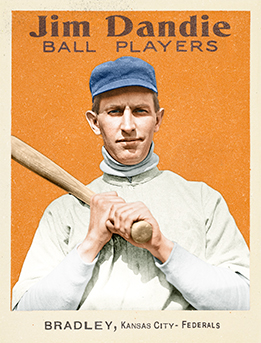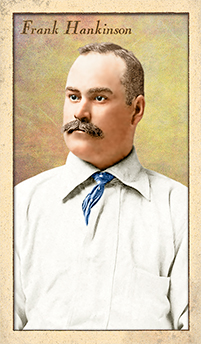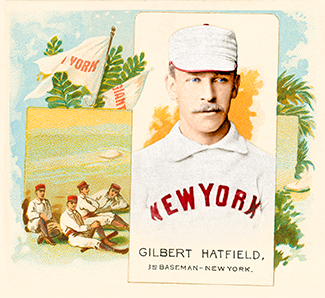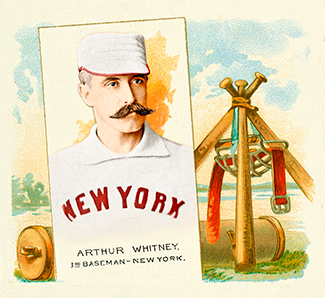- Series: 1888 Champion New York Giants
- City: New York
- Team: Giants
- League: National League
Gilbert Hatfield (1855-1921). A pitcher and infielder for 6 teams over 8 seasons, Hatfield did not break into the majors until the age of 30 – then played sporadically across the next decade – actually getting into 5 games with Louisville at the age of 40.
Hatfield was a member of the 1888 World Series Champion New York Giants. As a hitter, Hatfield went 2-8 in the series with 1 BB, 1 RBI & 1 Run. As a pitcher, Hatfield made 1 relief appearance, giving up 12 hits & 12 runs (7 earned) in 5 innings.
- Series: 1888 Champion New York Giants
- City: New York
- Team: Giants
- League: National League
Arthur Wilson Whitney (1858-1943). Art played 3rd base for 8 different teams over 11 major league seasons. A below average hitter, his best year may have been 1886 with the Pittsburgh Alleghenys when he compiled 122 hits, 13 doubles, 4 triples, 15 steals & 70 runs with a light .239 batting average.
- 2x World Series Champion with the New York Giants: 1888 & 1889
- Brother Frank Whitney also played professionally: 34 games for the Boston Red Caps in 1876

- Series: Jim Dandie Feds
- City: Kansas City
- Team: Packers
- League: Federal League
William Joseph Bradley (1878-1954) played third base better than anyone in the new American League until he was slowed by injury in 1906. Having jumped to the junior circuit from the Chicago Orphans in 1901, Bradley set batting and fielding marks for his hometown Cleveland Blues that would only be eclipsed by the likes of Ty Cobb and Home Run Baker. His pinnacle year came in 1902 when he batted .340, scored 104 runs with 39 doubles and 11 home runs, all putting him in the top five or six in the league. Bradley's output declined markedly following his injury-shortened season in '06. He stayed with Cleveland through the 1910 campaign, still playing regularly but seeing a great drop-off at the plate. He went to the International League's Maple Leafs as player-manager in 1911 but returned to the majors as manager for the Brooklyn Tip-Tops in the new Federal League where he put himself in as an occasional pinch hitter.The team's 77-77 record was good for a fifth-place finish. The next, and last, year for the Federal League saw him with the Kansas City Packers where Bill returned to a back-up role at third, playing in about half the club's games. Though known for his excellent fielding, Bradley figured uncharacteristically in a Cleveland no-hitter in 1908. Bob Rhoads hurled the gem but was shocked when he learned the hit he thought he'd surrendered on a grounder to Bradley had been ruled a rare error. His dazzling play at his position was a throwback to the earlier no-glove era as he mastered a bare-handed scoop-and-toss to throw out attempted bunters, per Stephen Constantelos of SABR. His rival as the best third-sacker of that decade, Jimmy Collins of Boston, told an admiring fan: “Well, if I could field and bat like Bradley, I should lay claim to that title myself.”
- On September 24, 1903 Bradley hit for the cycle in D.C. with 12 total bases
- Bradley's physical issues in 1906 had been presaged by a mysterious illness in '05 when his average began to drop. An intentional inside pitch from NY's Bill Hogg broke Bill's wrist, the first of a series of injuries that would plague him for the rest of his MLB tenure
- Hogg removed any doubt about his intention to disable Bradley when he vowed “The big Frenchman (Nap Lajoie) is next on my list.”

- Series: Jim Dandie Feds
- City: St. Louis
- Team: Terriers
- League: Federal League
Charles Albert Deal (1891-1979) like many of his peers in the early decades of baseball wanted to be fairly compensated for his talents, a concept alien to most of the owners of his day. Not even a spot on the Miracle Braves of 1914 could hold Deal's loyalty when the Federal League offered a chance at better pay. Charlie had played for Detroit in 1912-13 before joining Boston's club during the 1913 season. He was a decent third baseman who must have impressed his new team when he hit .306 late in '12. Unfortunately, although the 1914 Braves had a year for the ages, Charlie hit a mere .210 and saw greener pastures with the St. Louis Terriers in the Federal League's second and final season in '15. The move proved extremely lucrative for Deal. His salary ballooned from $2400 to $4500 plus a $3500 bonus. This may have been emblematic of the financial turmoil the Federals introduced and which led to the demise of such a profligate operation - in the minds of the establishment of the day. After the Terriers folded, Charlie played briefly for the Browns but found a home with the Cubs in 1916. In his tenure in the Windy City, interrupted by wartime obligations, Deal established himself as one of the best third basemen of the day. He never was able to hit much above his .250 norm but stayed with the Cubs through the 1921 season on the strength of his fielding prowess.
- Deal still had a taste for the game after ending his time in the big leagues. He went west and played for the Los Angeles Angels for two years and even played for the Vernon Tigers in 1924 in the industrial heart of South LA.
- Charlie moved up to Portland, still in the PCL, in '25 and wrapped up his professional career with the Southern Association's New Orleans Pelicans in 1926

- Series: 1880s: Spotted Ties
- City: New York
- Team: Metropolitans
- League: American Association
Frank Edward Hankinson (1856-1911) was a third baseman for four early National League clubs before ending his major league tenure with two American Association teams. Just why he was, primarily, a third baseman is a bit of a head scratcher. Frank debuted with the Chicago White Stockings in 1878 and hit a respectable .267 (an average he wouldn't exceed for a decade). Manager Bob "Death to Flying Things" Ferguson did start young Hankinson on the mound one time that rookie season, a complete game loss with the pitcher surrendering six runs. Ferguson must have seen something he liked as he used Hankinson much more in '79. As the back-up to Terry Larkin, Frank went 15-10 with an ERA nearly matching the ace (2.50 vs. 2.44 for Larkin). Perhaps it was Hankinson's anemic .181 BA that made him more desirable as a pitcher but, for unknown reasons, that would be basically a one-and-done “career” as a hurler in the majors. Thereafter, Hankinson labored as a NL part-timer mostly at third, although he played all positions but catcher over his ten-year span. His move to the AA saw him get many more plate appearances, especially with the Metropolitans from 1885-87.
- Overall, Hankinson hit .228 but compiled an impressive 16-12 record on the mound, completing all his starts and throwing two shut-outs. His ERA was 2.50.
- He closed out his career with '88's last-place Kansas City Cowboys, hitting a lifetime low .174
Auction History
Cartophilia
Old Judge Pose: 211-1




